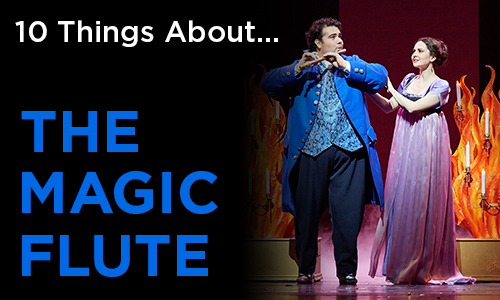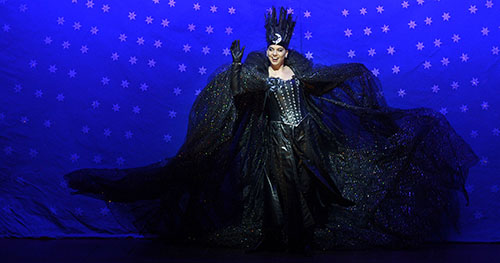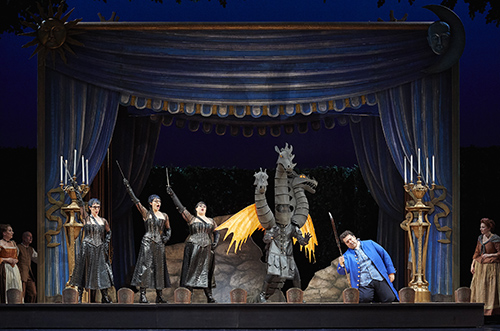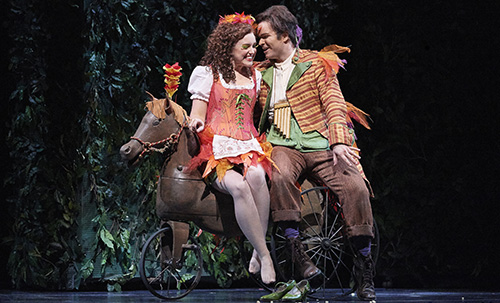-
10 Things About The Magic Flute!
By Tanner DaviesPosted in The Magic FluteBy Nikita Gourski, Development Communications Officer

The depth of Mozart’s genius is evidenced by his last opera, The Magic Flute. A child-like fantasy is paired with the master’s most stunningly beautiful music. Do you need to brush up on your Flute knowledge or simply want to learn more about our upcoming production? Here are 10 Things About The Magic Flute!
A classic Classical opera
Mozart worked during what is now known as the Classical period (roughly 1750-1820), when composers sought to move beyond the elaborate forms and “artificial” gestures of the Baroque era in order to capture raw human emotions—such as love, anger, sadness, etc.—with greater immediacy. Classical composers were interested in expanding the dramatic palette of music while simultaneously embracing simpler melodies that were written in evenly structured phrases, making them catchier and more memorable. (Indeed, The Magic Flute features possibly the catchiest passage for soprano ever written: the Queen of the Night aria in Act II.)
Mozart’s last and most popular
In his short lifetime, Mozart composed more than 600 works, including symphonies, piano sonatas, chamber music, choral masses, dances, concertos, art songs, and operas. He died less than two months after Flute had its world premiere in Vienna in 1791 and consequently never knew the full extent of its success: just over a year after the premiere, it celebrated its 100th performance and continued to grow in popularity ever since. Today, it is Mozart’s most frequently performed opera.
It’s a singspiel
Flute is the most famous example of a singspiel (meaning literally “sing-play” in German)—an operatic form in which musical numbers (arias, ensembles, etc.) alternate with sections of spoken dialogue.

It’s a fairy tale
The plot of Flute concerns a noble prince, Tamino, who is ordered by the mysterious Queen of the Night to rescue a beautiful kidnapped princess, Pamina. With the aid of his comic sidekick—the bird catcher Papageno—and the help of a magic flute, Tamino sets off on an epic quest through the trials and tribulations of love.
But it’s also about Freemasonry and the Enlightenment
Both Mozart and his friend Emanuel Schikaneder—who wrote the opera’s libretto and starred in the premiere as Papageno—were members of the same Masonic lodge, and the opera reflects their fascination with the rituals of Freemasonry. For example, in a nod to Masonic practices of initiation, Tamino goes through several rites of passage to enter the brotherhood of the temple before he can become worthy of Pamina’s love. Mozart was also immersed in the emerging ideas of the Enlightenment period—an intellectual attitude that placed reason at the centre of human potential—which is evidenced in the names of the temples Tamino must enter: Wisdom, Reason, and Nature.
A-list creative team
This COC production (premiered in 2011) was created by Tony Award-winning Broadway director Diane Paulus with set and costume designer Myung Hee Cho. “We wanted to capture the fairy tale aspect,” Paulus said at the time, “but also bring out the deeper meanings of enlightenment, and ritual, and Masonic architecture, and structure and enigma that are hidden inside.”
A play-within-a-play
Paulus and her team begin with an 18th-century “name day” party, at which the action of Mozart’s opera is being staged as part of the celebrations. Consequently we see a charming stage on the stage, where the opening scenes of the opera play out. But as we move further into the story, the initial framing device falls away, giving us the effect of getting lost in the opera and its story—not to mention a constantly rearranging garden maze—just as the party guests do.

Enchanting costumes
The costumes by Myung Hee Cho reflect the historical fashion of Mozart’s time (18th century) while incorporating contemporary influences and materials; for example, the spiked hair and leather outfits of the Queen of the Night and her three ladies. Cho also captures the essential fairy tale quality of Flute in her designs for the forest animals and three-headed dragon that appear in the show, all while keeping the feel of these creations decidedly low-tech, continuous with the notion that somebody is staging a play in their own garden.
Labadie takes the baton
This production features the COC debut of eminent Canadian conductor Bernard Labadie, who has performed with Glimmerglass, Santa Fe, and the Metropolitan Opera, among other prestigious destinations. “He moulds the phrases, plucks out all-important details in the texture and radiates an infectious joy in the music” (The Telegraph).
An Ensemble Showcase
This production features numerous artists—including tenors Andrew Haji and Owen McCausland as Tamino; Ambur Braid as Queen of the Night; and Jacqueline Woodley as Papagena—who are either graduates or current members of the COC’s Ensemble Studio training program. Their presence on the mainstage of one of the world’s finest opera houses speaks to the quality of preparation the Ensemble Studio has been delivering for more than three decades.

The Magic Flute is on stage at the Four Seasons Centre for the Performing Arts from January 19 to February 24. For more information and to purchase tickets, click here.
Photo credits (top - bottom): Andrew Haji and Elena Tsallagova in The Magic Flute (COC, 2017), photo: Michael Cooper; Ambur Braid as the Queen of the Night in The Magic Flute (COC, 2017), photo: Gary Beechey; Lauren Segal as the Third Lady, Emily D'Angelo as the Second Lady, Aviva Fortunata as the First Lady and Andrew Haji as Tamino in The Magic Flute (COC, 2017), photo: Michael Cooper; Jacqueline Woodley as Papagena and Joshua Hopkins as Papageno in The Magic Flute (COC, 2017), photo: Michael Cooper.
